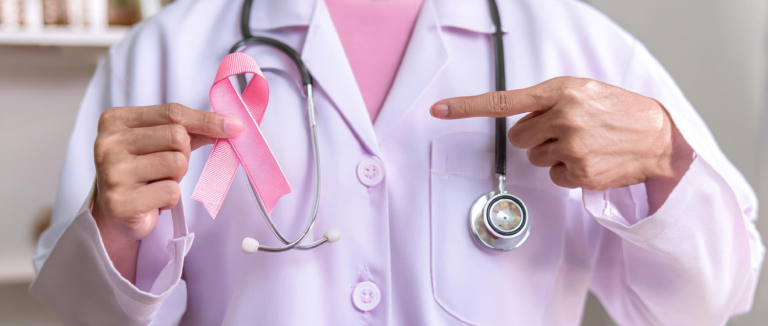Key Symptoms and Early Detection
Breast cancer is a disease caused by the abnormal and uncontrolled growth of cells within breast tissue, most commonly beginning in the milk ducts or glands. Over time, these cancerous cells may invade nearby tissues and can metastasize to other parts of the body. While it is is one of the most common cancers in women, it can also occur in men. Early detection and prompt treatment play a crucial role in improving the prognosis and success of therapy. Common symptoms include the presence of a lump in the breast, changes to the appearance or texture of the breast skin, and nipple discharge.

What is Breast Cancer?
It is a disease in which cells in the breast tissue multiply uncontrollably, leading to the formation of tumors. Over time, these abnormal cells can extend beyond the breast tissue and spread to other parts of the body. It is among the most common forms of cancer in women, and its chances of successful treatment are much higher when detected early. Risk factors include genetic predisposition, hormonal influences, age, lifestyle choices, and environmental exposures. Common symptoms are a lump or thickening in the breast, discharge from the nipple, pitting or crusting of the breast skin, and swelling in the armpit.
What Causes Breast Cancer?
The precise cause of Breast cancer remains unknown, but several risk factors are known to increase the likelihood of developing the disease. These include genetic predisposition, hormonal influences, age, lifestyle habits, and environmental exposures.
Some factors that may contribute to breast cancer include:
- Genetic Predisposition: Women with a family history of breast cancer face an increased risk of developing the disease. In particular, inherited genetic mutations”such as those in the BRCA1 and BRCA2 genes”can significantly elevate this risk.
- Hormones: Estrogen and progesterone, the primary female hormones, play a key role in the growth and development of breast tissue. Extended exposure to these hormones increases the risk of breast cancer. This risk becomes higher for women who begin menstruating at an early age, enter menopause later than average, or undergo hormone replacement therapy.
Lifestyle Factors:
- Obesity: Obesity, especially after menopause, is associated with a higher risk of developing cancer..
- Alcohol Consumption: Drinking excessive amounts of alcohol increases the risk of developing breast cancer.
- Smoking: Smoking is linked to an increased risk of developing breast cancer.
- Lack of Physical Activity: A lack of regular physical activity is associated with a higher risk of developing breast cancer.
Environmental Factors: Exposure to certain chemicals and radiation can also be risk factors.
In summary, breast cancer results from a complex combination of genetic, hormonal, lifestyle, and environmental factors. While some risks are unavoidable, maintaining healthy habits and getting regular check-ups can help lower your overall risk.
What are the Symptoms ?
It is a common disease among women, and when diagnosed early, the chances of successful treatment are quite high. Therefore, recognizing the symptoms of breast cancer is crucial for monitoring disease progression.
The most common symptoms of breast cancer include:
- A lump or thickened area in the breast, usually painless and detectable anywhere in the breast
- Nipple discharge, which may appear bloody, clear, or yellowish
- Dimpling or flaking of the skin on or around the nipple
- Swelling in the underarm area
- Redness or scaling of the breast skin
- Noticeable changes in breast size or shape
- The nipple turning inward (inversion)
- Skin of the breast appearing pitted, resembling the texture of an orange peel
Not all of these symptoms mean you have breast cancer, but any of them should prompt a consultation with your doctor. In some cases, symptoms may be subtle or not noticeable at all. This is why regular self-examinations and annual mammograms are important. Early detection greatly improves the likelihood of successful treatment.

How Is Diagnosed?
Several approaches are used to diagnose breast cancer. During this process, your doctor will review your medical history, perform a physical examination, and may order further tests to confirm the diagnosis.
Methods Used in the Diagnosis Process:
- Physical Examination: A doctor checks for lumps, masses, or other abnormalities in the breasts and underarms.
- Mammography: An X-ray imaging technique considered one of the most effective ways to detect breast cancer early.
- Ultrasound: Uses sound waves to create images of breast tissue, often used with mammography to better evaluate cysts or tumors.
- Magnetic Resonance Imaging (MRI): Provides detailed images of the breast, especially helpful for women with dense breast tissue or when other imaging results are unclear.
- Biopsy: Involves taking a small sample of breast tissue for microscopic examination, providing a definitive cancer diagnosis.
- Hormone Receptor Tests: Measures how cancer cells respond to hormones like estrogen and progesterone, guiding treatment decisions.
- Genetic Testing: Includes tests for genetic mutations, such as BRCA, to assess individual risk”especially for those with a family history of breast cancer.
How is Treated?
Treatment for breast cancer is tailored to the cancer's stage, type, and the patient's overall health. The primary treatment approaches usually include:
- Surgical Treatment:
- Lumpectomy: Removal of the tumor and a small amount of surrounding healthy tissue.
- Mastectomy: Removal of all or part of the breast tissue. Mastectomy may be preferred in cases of invasive cancer.
- Lumpectomy: Removal of the tumor along with a small margin of healthy tissue.
- Mastectomy: Removal of all or part of the breast tissue. This option may be necessary for invasive cancers.
- Radiation Therapy: Uses high-energy rays to destroy lingering cancer cells, commonly given after a lumpectomy.
- Chemotherapy: Drug therapy to kill cancer cells, which can be administered before surgery (neoadjuvant), after surgery (adjuvant), or for advanced cancers.
- Hormonal Therapy: Used for hormone-sensitive breast cancers. Medications such as tamoxifen or aromatase inhibitors help lower hormone levels or block their effects.
- Targeted Therapy: Focuses on specific genetic or molecular features of cancer cells. For instance, trastuzumab (Herceptin) is used for HER2-positive breast cancer.
- Immunotherapy: Experimental treatments that aim to stimulate or strengthen the immune system to fight certain types of breast cancer.
Treatment plans are usually developed by a multidisciplinary team, including doctors, surgeons, oncologists, and radiologists, who collaborate to provide the best possible care for each patient. Emotional support and resources, such as psychological counseling and support groups, are also valuable during the treatment journey.
* Liv Hospital Editorial Board has contributed to the publication of this content .
* Contents of this page is for informational purposes only. Please consult your doctor for diagnosis and treatment. The content of this page does not include information on medicinal health care at Liv Hospital .
For more information about our academic and training initiatives, visit Liv Hospital Academy

Frequently Asked Questions
What is breast cancer?
Breast cancer occurs when cells in the breast grow uncontrollably, forming a tumor that can invade nearby tissues or spread to other parts of the body.
What are the early signs of breast cancer?
Common signs include a lump in the breast, nipple discharge, changes in breast shape, or skin dimpling resembling an orange peel.
Can men get breast cancer?
Yes, although rare, men can also develop breast cancer, usually presenting as a lump behind the nipple or changes in skin texture.
How often should I have a breast examination?
It is recommended that women perform monthly self-examinations and undergo a clinical breast exam or mammogram annually, depending on age and risk factors.
What increases the risk of developing breast cancer?
Genetic mutations, hormonal changes, obesity, alcohol use, lack of physical activity, and prolonged exposure to estrogen can increase risk.
How is breast cancer diagnosed?
Diagnosis is made through a physical exam, mammography, ultrasound, MRI, and biopsy to confirm the presence of cancer cells.
What treatment options are available for breast cancer?
Treatments include surgery, radiation therapy, chemotherapy, hormonal therapy, targeted therapy, and, in some cases, immunotherapy.
Is breast cancer curable?
When detected early, many types of breast cancer can be effectively treated and even cured, depending on the stage and response to therapy.
Can lifestyle changes help prevent breast cancer?
Maintaining a healthy weight, exercising regularly, limiting alcohol, and avoiding smoking can lower your risk of developing breast cancer.
Where can I get breast cancer treatment in Türkiye?
Liv Hospital in Istanbul offers advanced diagnostic and treatment options with a multidisciplinary team of oncology specialists and modern facilities.



